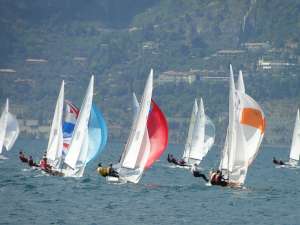
Was it worth it? A typical question after a mediocre performance. In my case the answer is an emphatic yes, not only because it was such a beautiful venue but also lessons learned. Catching up with old friends and acquaintances was also a big highlight.
Pavel and I arrived had no preconceived idea how we would perform, as we had not sailed together for over a year before the Nationals. We had decided to refurbish US-1453, a 1984 Lindsay, with the latest ideas that included new spars and foils. What we found at this years worlds, was that we were lacking in most departments including equipment, large fleet experience,against teams that I firmly believe have improved since we last sailed against them. Therefore, Lin and Richard’s placings are probably more indicative of the state of the US FD standard than ours.
I won’t go too much into the starting issues as Lin has already commented elsewhere, but I will add that there seems to be different standards between regattas as to what the RC will tolerate. I agree with Torban Graels recent comments and feel that a crackdown on starting at this level would make racing fairer. His comment on bringing out the black flag for the first start, certainly at this level, and perhaps making it for the formed triangle only, combined with a consistent tough stance by the RC’s, could cut out the nonsense that currently persists.
The regatta got more difficult for us after race six, when the fleet was split into gold and silver. Being in the gold fleet, we found that being grouped with the top sixty-five boats meant even more aggressive starting techniques and less clear lanes and gaps to maneuver in. This meant that it became even easier to have poor results if you made even the slightest of mistakes. The decision to run three gold/silver fleet races on the final day and with the morning race being abandoned after the second windward leg, effectively made it a four race day. This took its toll, and left me both physically and mentally exhausted. A lesson here is to get fitter.
The basis for attending the Worlds on Lake Garda was to gain a realistic perspective of where we are at present and use this as a platform to build toward getting internationally competitive for next years worlds in Santa Cruz. In our case, some of the system changes we made saw knock-on effects that caused handling difficulties. These probably wouldn’t have been so obvious if we hadn’t been competing at this level. The aim now is to finesse these improvements as well as spend some time on the water together. There is a steep mountain to climb and the journey for us begins today.

